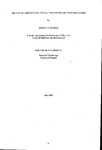THE SOCIAL AND PSYCHOLOGICAL EFFECTS OF SMS TEXT MESSAGING
| dc.contributor.author | REID, DONNA JANE | |
| dc.contributor.other | Faculty of Science and Engineering | en_US |
| dc.date.accessioned | 2013-09-10T11:32:36Z | |
| dc.date.available | 2013-09-10T11:32:36Z | |
| dc.date.issued | 2007 | |
| dc.identifier | NOT AVAILABLE | en_US |
| dc.identifier.uri | http://hdl.handle.net/10026.1/1635 | |
| dc.description.abstract |
This thesis reports an exploration of the phenomenon of mobile phone SMS text messaging and examines the applicability of two key theories of computer-mediated communication that forecast contrasting outcomes of this medium for personal relationship development and maintenance. It explores how SMS texting is being used, the impact it can have on the formation and maintenance of interpersonal relationships, and its attraction to particular groups of users. The importance of individual differences in moderating the use and outcomes of text messaging is emphasised throughout the studies reported. The investigation was split into two phases. An exploratory phase analysed samples of text messages collected in one-shot studies (Studies 1 and 2) and a longitudinal study (Study 3), and provided initial evidence for the social-relational use of SMS that refuted a cues-filtered-out approach. These Studies also focussed the investigation on the hyperpersonal potential of SMS – the possibility that text messaging can facilitate more intimate contact than can be achieved in face-to-face settings. Study 4 examined the uses and gratifications of text messaging and revealed that there were two groups of users (‘Texters’ and ‘Talkers’) who differed in their motivations for using the medium. The experimental phase extended the Hyperpersonal Model, first by examining the role of perceived affordances and individual differences in impression formation in text interactions between strangers (Studies 5 and 6), and second by examining more closely two processes assumed to contribute to hyperpersonal communication in this setting – selective self-presentation by the sender, and the over-attribution of personal characteristics to the sender by the receiver (Studies 7 and 8). These latter studies utilised a novel quasi-signal detection approach to investigate this in more detail. It was found that over-attribution had a stronger impact on some of the impressions formed, although there was tentative evidence for a sender effect too, suggesting a combination of these two processes is at work. A weak and strong version of the Hyperpersonal-Model was discussed, whereby communication can indeed become hyperpersonal for certain people who have discovered the social affordances of the medium. To accommodate this, a Social Affordances Model of Text Messaging was developed over the course of the thesis to explain how SMS is used and its potential outcomes. The present results suggest that those who are socially anxious are more likely to prefer using their mobile to text rather than to talk, and this in turn is related to more expressive message content and social-relational uses and gratifications beliefs. These findings point towards the importance of the affordances of visual anonymity, asynchronicity and text-based communication, which together make text messaging an important medium for individuals to gain control over their self-presentation on challenging interpersonal relationships. This adds to the existing literature as it identifies individual differences, specific affordances of text messaging and potential relational outcomes. This thesis argues that there is an interaction between the technological and psychological affordances of text messaging and the ability of individuals to recognise these and to capitalise on them when needed. | |
| dc.language.iso | en | en_US |
| dc.publisher | University of Plymouth | en_US |
| dc.title | THE SOCIAL AND PSYCHOLOGICAL EFFECTS OF SMS TEXT MESSAGING | en_US |
| dc.type | Thesis | |
| plymouth.version | Full version | en_US |
| dc.identifier.doi | http://dx.doi.org/10.24382/3781 |
Files in this item
This item appears in the following Collection(s)
-
01 Research Theses Main Collection
Research Theses Main


